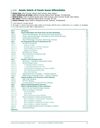Physiology of Male Gonadotropic Axis and Disorders of Sex Development
January 2017
in “
Springer eBooks
”
TLDR Understanding genes and hormones is crucial for managing male puberty and sex development disorders.
The document reviewed the physiology of the male gonadotropic axis and disorders of sex development (DSD). It discussed the neurobiological mechanisms of puberty onset, the role of Sertoli cells in testicular function, and the classification of male hypogonadism. Key findings included the importance of kisspeptin in regulating puberty and the impact of mutations in genes like MKRN3 and GPR54 on precocious puberty and hypogonadotropic hypogonadism. The document also covered the hormonal regulation of Sertoli cell differentiation, the role of inhibin and activin in spermatogenesis, and the clinical implications of anti-Mullerian hormone in DSD. The review highlighted the genetic and molecular bases of various DSDs, emphasizing the significance of molecular diagnostics in understanding and managing these conditions.
